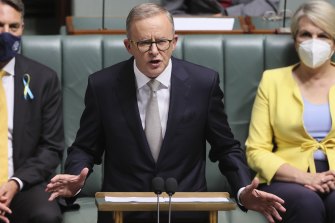With the official election campaign expected to kick off within days, Labor is finally showing signs that it will make its small target somewhat bigger. Opposition Leader Anthony Albanese used his budget reply speech to put some flesh on the bones of Labor’s policies. At its heart was a $2.5 billion pledge to improve the treatment of older Australians.
His package would force every aged care facility to have a registered nurse on site 24/7, hire more carers, set higher standards for meals and fully fund a boost for workers through an appeal to the Fair Work Commission to set higher wages.
Anthony Albanese delivers his budget reply speech.Credit:Alex Ellinghausen
He also promised billions of dollars for local industry and manufacturing, more defence spending, cheaper childcare for “almost every family” and a $10 billion housing fund to build more social and affordable housing.
It would be hard to argue against any of it. Labor has ticked off a few more of the royal commission into aged care’s extensive list of recommendations, the war in Ukraine and China’s growing global ambitions have given defence spending a new urgency, childcare is essential for giving parents, particularly women, full access to the workforce and the pandemic exposed our reliance on overseas manufacturing for too many essential goods.
There is though an obvious catch. One that the Coalition also chose to largely ignore in its budget on Tuesday: paying for it all. During the pandemic, all Australian governments spent enormous amounts buttressing the economy and providing the expanded health services needed to keep people safe. It was the right decision. Not only did it lay the foundation for Australia’s quick economic recovery, but it ensured the death toll in Australia from COVID-19 has been relatively small.
That legacy of spending now weighs heavily on the bottom line. The budget is forecast to show a $78 billion deficit for the 2022-23 financial year after a $79.8 billion shortfall in the current year. Gross debt is on track to break $1 trillion in 2023-24.
The government is right to say a growing economy is the best means of paying down the debt, but doing so will also require policy leadership on a range of reform fronts that both sides of politics are unwilling to undertake, particularly in the shadow of an election. And even if the economy were to perform well over the next few years, at some point we must return to an acceptance that extra spending must be accompanied by more revenue.
There is room for trimming. The tax concessions on superannuation, negative gearing and franking credits are very generous, and mostly benefit those on higher incomes. The Age accepts that Labor, at the last election, paid a heavy price for putting forward cuts in some of these areas, but that does not diminish the economic argument for gradually winding them back.
Labor has been out of power at a federal level for just over 8½ years. While the party is ahead in the polls, it has been here before, and there is no guarantee of victory. This time around, Mr Albanese is banking on the Australian public falling out of favour with the Coalition more than finding favour with Labor. It’s a risky approach, but the Coalition does look tired after two years of managing the pandemic, book-ended with fires and floods.
This is a critical time for Australia. During the next decade, our national government will face not only its share of domestic challenges but the consequences of climate change and, with the rise of China, a rapidly changing geopolitical landscape. While the budget reply was a start, Mr Albanese still has much to do to prove he is up to the task.
Gay Alcorn sends an exclusive newsletter to subscribers each week. Sign up to receive her Note from the Editor.
Most Viewed in Politics
From our partners
Source: Read Full Article


